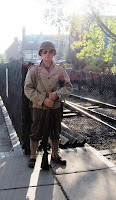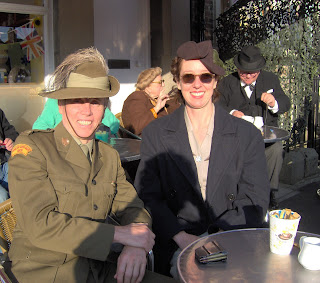 |
| WWSA 063 |
 |
| WWSA 067 |
 |
| WWSA 069 |
Click on photo's to enlarge.
I noticed quite a large number of the military personnel had been 'decorated' by the local ladies, with red kisses on their cheeks.
It's the uniform that does it every time.
All the photo's shown here were all taken on Saturday afternoon. If you spot yourself here, and would like a copy of the photo, take a note of the code number beneath it and email me. I will send you a .jpg copy via email.
 |
| WWSA 077 |
There were a large number of wonderful vintage cars on show along the main streets,
along with military vehicles of all types, jeeps, tanks, trucks, military motorcycles, and a beautiful old traction engine.
 |
| WWSA 078 |
The next photo is of a beautiful cream coloured Bentley, occupied by two lovely, and well dressed ladies. What a wonderful way to travel. There seemed to be some doubt about whether the lady in the driving seat had legs, though she kept assuring teasing friends that she had actually left the car for a few minutes!
 |
| WWSA 083 |
 |
| WWSA 081 |
 |
| WWSA 086 |
impressive moustaches! I couldn't resist them, I happen to like beards and moustaches, my husband has both, I threatened to divorce him if he ever tried to shave them off!
 |
| WWSA 079 |
 |
| WWSA 080 |
Yup.... they're over here .. but I can't say too much
cos I am married to one..!
 |
| WWSA 088 |
 |
| WWSA 087 |
I loved the little produce van that was parked near the station, that's a friend standing in front of it.
 |
| WWSA 114 |
 |
| WWSA 094 |
The soldier on the right is on sentry duty I think.  |
| WWSA 096 |
As the air raid siren sounded, the crowd on platform 2 at Pickering Railway Station calmly made their way to the air raid shelter, chivvied by the ARP's, whilst the Home Guard (lovingly known as 'Dad's Army') get ready to fire on any dive-bombing enemy aircraft.
Members of our Senior Service
 |
| WWSA 122 |
 |
| WWSA 121 |
This young man from Sidney, Australia is representing the ANZACS, where would we have been without all our brave allies. He seemed to have an inkling of the future, knew all about computers...!
 |
| WWSA 123 |
Unfortunately, due to camera shake, the photo of this young boy soldier is blurred, but I got a better one next day. He wasn't playing his ukelele though. Here he was collecting for Platoon funds.
More photo's next week, from Sunday the 16th. including 'capture' of four SS Panzer Tank personnel, and if I can figure out how to do it, possibly a slide film of other pics I took on both days, featuring vintage cars, trains and other scenes.
For more photo's from around
Our World Tuesday
visit HERE




























